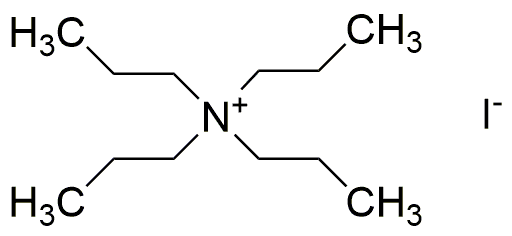Tetrapropylammonium iodide is widely utilized in research focused on:
- Phase Transfer Catalysis: This compound acts as an efficient phase transfer catalyst, facilitating reactions between organic and aqueous phases, which is particularly useful in organic synthesis and industrial processes.
- Electrochemistry: It is employed in electrochemical applications, enhancing the conductivity of ionic liquids and improving the performance of batteries and supercapacitors.
- Ion Exchange Processes: In water treatment and purification, it serves as an ion-exchange agent, effectively removing contaminants and improving water quality.
- Organic Synthesis: Researchers use it to synthesize various organic compounds, benefiting from its ability to stabilize reactive intermediates and promote desired reactions.
- Pharmaceutical Development: The compound plays a role in drug formulation, particularly in enhancing solubility and bioavailability of poorly soluble drugs, making it valuable in the pharmaceutical industry.
General Information
Properties
Safety and Regulations
Applications
Tetrapropylammonium iodide is widely utilized in research focused on:
- Phase Transfer Catalysis: This compound acts as an efficient phase transfer catalyst, facilitating reactions between organic and aqueous phases, which is particularly useful in organic synthesis and industrial processes.
- Electrochemistry: It is employed in electrochemical applications, enhancing the conductivity of ionic liquids and improving the performance of batteries and supercapacitors.
- Ion Exchange Processes: In water treatment and purification, it serves as an ion-exchange agent, effectively removing contaminants and improving water quality.
- Organic Synthesis: Researchers use it to synthesize various organic compounds, benefiting from its ability to stabilize reactive intermediates and promote desired reactions.
- Pharmaceutical Development: The compound plays a role in drug formulation, particularly in enhancing solubility and bioavailability of poorly soluble drugs, making it valuable in the pharmaceutical industry.
Documents
Safety Data Sheets (SDS)
The SDS provides comprehensive safety information on handling, storage, and disposal of the product.
Product Specification (PS)
The PS provides a comprehensive breakdown of the product’s properties, including chemical composition, physical state, purity, and storage requirements. It also details acceptable quality ranges and the product's intended applications.
Certificates of Analysis (COA)
Search for Certificates of Analysis (COA) by entering the products Lot Number. Lot and Batch Numbers can be found on a product’s label following the words ‘Lot’ or ‘Batch’.
Numéro de catalogue
Numéro de lot/série
Certificates Of Origin (COO)
This COO confirms the country where the product was manufactured, and also details the materials and components used in it and whether it is derived from natural, synthetic, or other specific sources. This certificate may be required for customs, trade, and regulatory compliance.
Numéro de catalogue
Numéro de lot/série
Safety Data Sheets (SDS)
The SDS provides comprehensive safety information on handling, storage, and disposal of the product.
DownloadProduct Specification (PS)
The PS provides a comprehensive breakdown of the product’s properties, including chemical composition, physical state, purity, and storage requirements. It also details acceptable quality ranges and the product's intended applications.
DownloadCertificates of Analysis (COA)
Search for Certificates of Analysis (COA) by entering the products Lot Number. Lot and Batch Numbers can be found on a product’s label following the words ‘Lot’ or ‘Batch’.
Numéro de catalogue
Numéro de lot/série
Certificates Of Origin (COO)
This COO confirms the country where the product was manufactured, and also details the materials and components used in it and whether it is derived from natural, synthetic, or other specific sources. This certificate may be required for customs, trade, and regulatory compliance.


